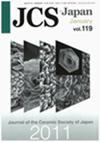CdX (X = S, Se和Te)中Shockley-partial位错的电子和原子结构
IF 1.1
4区 材料科学
Q3 MATERIALS SCIENCE, CERAMICS
引用次数: 0
摘要
II-VI半导体,包括Cd化合物,在光照下变脆。这种现象被称为光塑性效应(PPE),被认为是由滑动位错和光激发载流子之间的相互作用引起的。本研究通过密度泛函理论(DFT)计算研究了CdX (X = S, Se和Te)中有和没有多余载流子的30°Shockley-partial位错的原子结构。发现当多余载流子缺失时,Cd和阴离子核都有利于未重构的原子结构。另一方面,在过量载流子存在的情况下,重构的原子结构在阴离子核处更稳定,而未重构的原子结构在Cd核处仍然更有利。因此,我们预计只有阴离子核通过光照改变其原子结构,从而通过形成类原子键来延缓滑动位错运动。局域态密度(LDOSs)分析表明,重构的镉核和阴离子核在带隙内分别形成浅缺陷态和深缺陷态。这决定了在外部光激发的多余载流子存在的情况下,位错核心处可能的原子重建。本文章由计算机程序翻译,如有差异,请以英文原文为准。
Electronic and atomic structures of Shockley-partial dislocations in CdX (X = S, Se and Te)
II–VI semiconductors, including Cd compounds, become brittle under light illumination. This phenomenon is known as the photoplastic effect (PPE) and is thought to arise from interactions between glide dislocations and photoexcited carriers. The present study investigated atomic structures of 30° Shockley-partial dislocations with and without excess carriers in CdX (X = S, Se and Te), by density-functional-theory (DFT) calculations. It was found that both Cd and anion cores favor unreconstructed atomic structures when excess carriers are absent. In the presence of excess carriers, on the other hand, reconstructed atomic structures were more stable at the anion cores while the unreconstructed ones were still energetically more favorable at the Cd cores. It is thus expected that only the anion cores change their atomic structures by light illumination, which can retard glide-dislocation motion by forming like-atom bonds. Analyses of local densities of states (LDOSs) revealed that the reconstructed Cd and anion cores form shallow and deep defect states within the band gaps, respectively. This determines the possible atomic reconstructions at the dislocation cores in the presence of excess carriers excited by external light.
求助全文
通过发布文献求助,成功后即可免费获取论文全文。
去求助
来源期刊

Journal of the Ceramic Society of Japan
工程技术-材料科学:硅酸盐
CiteScore
2.10
自引率
18.20%
发文量
170
审稿时长
2 months
期刊介绍:
The Journal of the Ceramic Society of Japan (JCS-Japan) publishes original experimental and theoretical researches and reviews on ceramic science, ceramic materials, and related fields, including composites and hybrids. JCS-Japan welcomes manuscripts on both fundamental and applied researches.
 求助内容:
求助内容: 应助结果提醒方式:
应助结果提醒方式:


